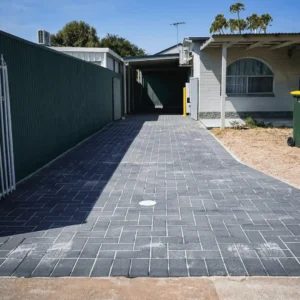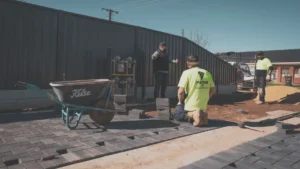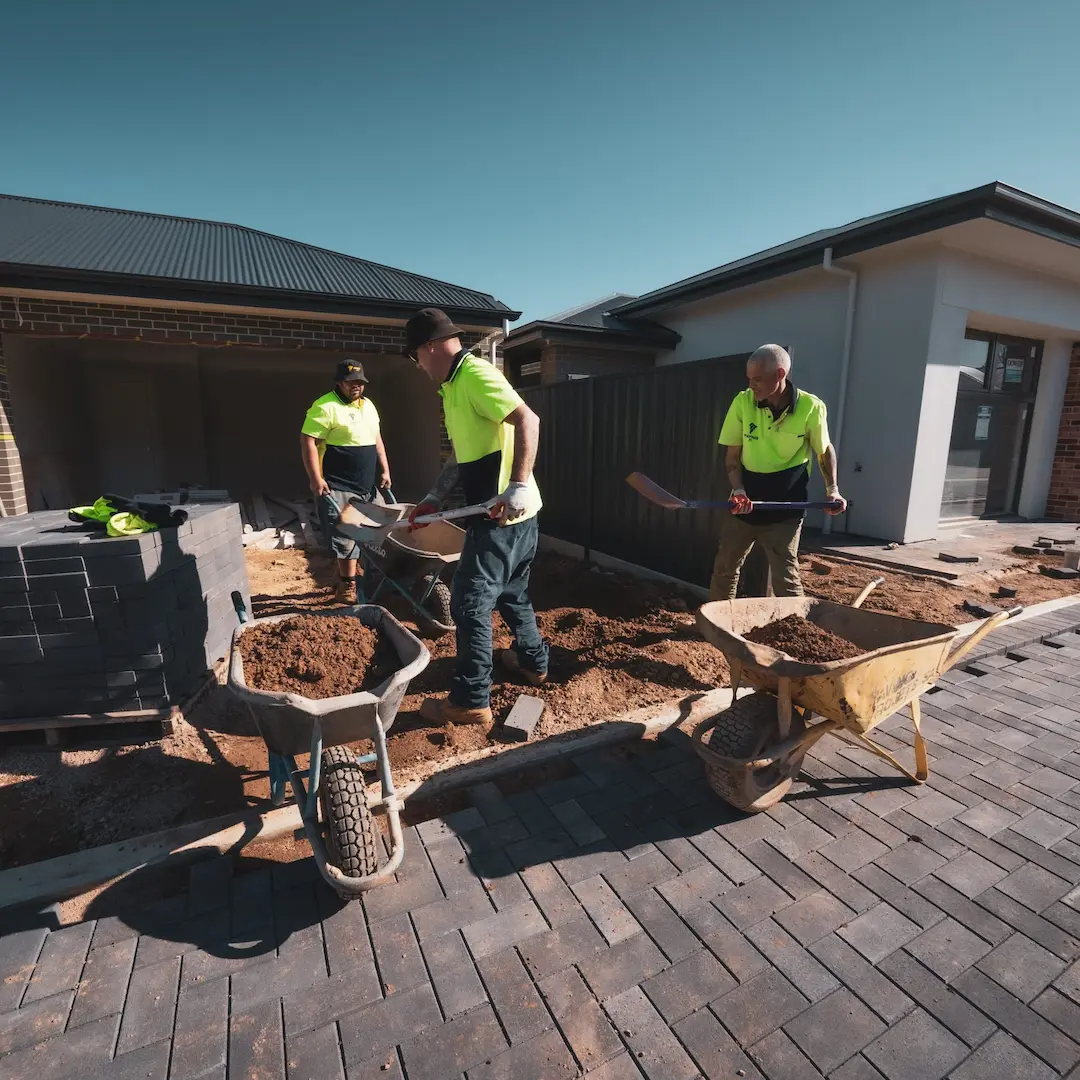Tired of weeds ruining your paving? This article goes straight to the point, detailing practical steps on how to get rid of weeds in paving. From hand-pulling to eco-friendly solutions and maintenance tips to prevent future growth, we’ll guide you to a clean, weed-free surface without the fluff or sales pitches. If you’re in need of a paving layer, speak to the team at Paving SA for a free quote on your next paving project!
Key Takeaways
- Hand pulling weeds, along with specialised weeding tools, provide an environmentally friendly method for removing weeds from paving, with weeding being most effective before they seed and during cooler hours.
- Boiling water, salt, and baking soda are cost-effective and natural weed killers that can be applied directly to weeds between pavers, while vinegar solutions require care to avoid damage to desired plants and pavements.
- Preventative methods like using polymeric sand for re-sanding, sealing paving stones, and ensuring proper drainage are important for keeping weeds at bay and maintaining the aesthetics of paved surfaces.
Hand Removal Techniques for Weeds in Paving
Hand removal techniques for weeds epitomise the phrase “direct action”. These methods, which include pulling weeds by hand or using specialised weeding tools, are not just effective but also environmentally friendly. They are the first line of defense in your fight against driveway weeds. Weed killer, while effective, is often seen as a last resort due to its potential harmful effects on the environment.
The optimal time for manually removing weeds is before they go to seed, and during cool hours of the day, such as at night or early in the morning. This is to minimise wind and sunlight interference, which can help prevent future weed growth.
Start the manual removal process by pulling weeds directly from the ground. After you’ve successfully pulled out the weeds, it’s a good idea to use a weed killer to address any remaining weeds and prevent them from growing back.
Pulling Weeds by Hand
While pulling weeds by hand might seem straightforward, there’s actually a technique to it. The best way to remove weeds without leaving roots behind is to grasp them at the base and pull them out by the roots. You can use a hand-held weed puller tool for narrow spaces. It’s also recommended to wear thick and durable gloves made of materials like leather or polyurethane-coated fabric to protect against pricks and scratches.
Hoeing or pulling weeds from pavers is easier when the soil surface is somewhat dry, facilitating the removal of the entire weed, including the roots. Once you’ve pulled out the weeds, dispose of them in a black plastic bag, seal it, and leave it in the sun for a few weeks. The heat generated inside the bag will effectively kill the weeds, preventing them from re-sprouting.
Using Weeding Tools for Narrow Spaces
Although hand-pulling weeds works well for larger areas, it becomes challenging when weeds grow in narrow spaces between pavers. That’s where specialised weeding tools come in. These tools, such as v-notch and cape code weeders, block paving knives, or even a kitchen knife, can help you eliminate weeds from difficult-to-reach areas like gaps and cracks.
Tools specifically designed for narrow spaces, such as block paving knives or paver weeders, are particularly effective. For instance, the Cape Cod weeder is utilised for slicing through weeds and loosening tough soils, making it highly efficient for weed removal in confined areas or between plants.
Natural Weed Killers: Boiling Water, Salt, and Baking Soda
For those seeking budget-friendly and green ways to eradicate weeds in paving, natural weed killers can be the solution. Among the most accessible and effective natural weed killers are boiling water, salt, and baking soda. Each of these methods has its unique advantages, and they can be particularly effective when used in combination.
In the boiling water method, persistent weeds growing between pavers are tackled by:
- Pouring hot water from a kettle onto them.
- It is especially effective in killing young and newly emerged weeds.
- It can reach weeds wedged into cracks where other methods may not reach.
Contrarily, you can apply salt directly into the gaps between patio pavers. An effective weed-killing solution can be created using a ratio of three parts water to one part salt.
Boiling Water Method
Using the boiling water method is a fairly straightforward technique for eliminating weeds between pavers. It works by dehydrating the weed’s root system as the hot water penetrates the soil, causing the collapse of the plant’s cell structure. This intense heat directly affects both seeds and roots by dehydrating and causing structural collapse, leading to their demise.
The process includes boiling water in a kettle, cautiously transporting it outdoors, and pouring it directly onto the weeds growing between the pavers. It’s safe for all types of paving materials, but remember to wear long pants, sleeves, and closed-toe shoes to protect against spills or accidental splashes.
Salt Treatment
Applying salt is another potent method to exterminate weeds between pavers. It involves applying sodium chloride, also known as table salt, in the cracks of your driveway or between pavers. Salt kills weeds by causing dehydration and disrupting the internal water balance of plant cells. It prevents growth by creating a hostile environment that makes it difficult for weeds to absorb water and nutrients.
To effectively treat weeds while minimising harm to the environment, sprinkle a small amount of rock salt directly onto the foliage of weeds or wet the weeds and surrounding area before applying the salt. If using a solution of water and salt, it can help lessen the harm to pavers and other plants.
Baking Soda Technique
Another key weapon in our natural weed killers arsenal is the baking soda technique. It’s a selective weed killer that can be applied multiple times without harming other plants. Baking soda eliminates weeds by causing damage to the parts of the plant it comes into contact with, primarily the foliage, while typically avoiding impact on the root systems. However, if applied in significant quantities directly to the soil, it has the potential to harm nearby plants.
This method is most effective during spring and fall, but it can still be effective during summer. To prevent weed growth on a patio, pour baking soda over the surface and sweep it into the cracks, re-applying every four to six weeks for the best results.
Targeting Weeds with Vinegar Solutions
If white vinegar is available in your pantry, it serves as an additional tool in your battle against weeds. Vinegar is a cost-effective and eco-friendly weed killer that can be used to target weeds in paving. However, it’s important to handle vinegar with care to avoid damaging wanted plants and pavers. To create a vinegar solution for weed removal, spray vinegar directly onto the leaves and stems of the weeds. For enhanced weed-killing effectiveness, consider adding approximately a teaspoon of dish soap to the mixture.
The most effective strength of vinegar for weed removal is 20% acetic vinegar, which is extremely fast-acting and will result in brown, withered weeds within 24 hours. However, this method does carry some risks. The use of vinegar solutions near flower beds and on paving stone driveways, patios, or walkways can pose several risks. Vinegar and salt have the potential to change the soil’s pH level, potentially causing harm to nearby plants and wildlife, and can also cause etching on the pavers.
Creating a Vinegar Solution
It’s fairly simple to create a vinegar solution for weed removal. The typical base composition for a vinegar solution used for weed removal is usually a mixture of half water and half white vinegar. To boost its effectiveness, add a teaspoon of dish soap to the mixture. Dish soap serves as a surfactant, aiding in breaking down the outer coat of the plant to enhance the solution’s effectiveness.
In addition to white vinegar, you can also use apple cider vinegar, which has a slightly higher level of acidity and can be more effective at killing tougher weeds.
Application Tips and Precautions
Adhering to safety precautions is vital when deploying vinegar solutions for weed control. Here are some safety tips to keep in mind:
- Wear goggles, gloves, secure clothing, and a face mask or respirator if using concentrated vinegar.
- To minimise contact with skin and eyes, use a spray bottle and rinse immediately with saline or fresh water if splashes occur.
- Remove contact lenses prior to rinsing.
To safeguard beneficial plants, you can take the following steps:
- Create a physical barrier using materials like plastic or cardboard to prevent weeds from spreading.
- Apply the vinegar solution carefully directly to the weeds, making sure to avoid contact with desired plants.
- If vinegar solution accidentally comes into contact with desired plants, immediately spray them with water to wash off the vinegar.
These measures will help protect your plants while effectively dealing with weeds, including the option to burn weeds, kill weeds, or even consider killing weeds.
Eliminating Weeds with a Weed Torch
Watching weeds wilt and perish under the heat of a weed torch can be undeniably satisfying. A weed torch, typically fuelled by propane, is used to burn unwanted weeds, particularly those nestled between pavers, thereby eliminating them. However, it’s crucial to follow safety guidelines when using a weed torch.
After you’ve successfully torched the weeds, it’s important to extract the roots of the weeds from the soil and fill the gaps between the slabs or stones with caulk or Polymeric sand to inhibit the regrowth of weeds. A weed torch is generally available for under $50, making it a cost-effective tool for individuals seeking to control weeds in their paving.
Weed Torch Basics
A weed torch operates by rapidly heating the weed’s leaves to a high temperature, which disrupts photosynthesis and effectively eliminates the weed. It’s particularly effective for small weeds measuring 1-4 inches, and larger weeds may require multiple flamings. After being torched, weeds typically die or are stunted within a few days, depending on their size.
The weeds that are most effectively treated with a weed torch include annual weeds, seedlings of broom species, poison hemlock, stinkwort, yellow star thistle, and very young grasses. Using a weed torch offers several advantages, such as cost savings on repetitive treatments, ease of use, low maintenance, and safety as it doesn’t involve chemicals.
Safety Guidelines and Tips
Safety should always be your top priority when using a weed torch. Always follow manufacturer instructions to ensure the safe operation of the equipment and minimise the risk of accidentally damaging plants or pavers. It’s also vital to wear protective gear, including work boots that cover the ankles, long cotton/denim pants, head protection with eye and ear protection, and thick work gloves.
If an accidental fire is caused by a weed torch, maintain a steady hand and be prepared with means to quickly extinguish the fire.
Pressure Washing Weeds Away
While pressure washing is widely known for cleaning patios, driveways, and other outdoor areas, it can also serve as an efficient technique for weed removal from paving. It’s a straightforward process that involves using a high-pressure water spray to dislodge and wash away the weeds. However, proper setup and technique are crucial in ensuring that pressure washing is effective and doesn’t cause damage to your paving.
To prepare for pressure washing, follow these steps:
- Manually remove larger weeds.
- Set up the pressure washer with the appropriate nozzle to prevent any damage to the pavers.
- Use a rotating surface cleaning attachment to enhance the pressure washing procedure by effectively eliminating weeds and concurrently cleaning the hardscape.
However, you must be careful when using a pressure washer to avoid displacing the sand from around and under the pavers, as this can potentially compromise the stability of the paving.
Pressure Washer Setup
When setting up the pressure washer, select a suitable nozzle that can effectively remove weeds and moss without causing harsh impact on the surface and indentations. Begin with a low pressure setting and gradually increase it as needed, while avoiding prolonged concentrated spraying on the pavers to prevent damage. Suitable nozzles include those designed for concrete, hot water high-pressure cleaners, targeted nozzles for precise work, or turbo nozzles for a higher impact on the surface to be cleaned.
To effectively remove weeds, set the pressure washer to a constant working temperature of 90-95°C and maintain a pressure between 2,000 and 2,500 PSI.
Tips for Effective Weed Removal
Pressure washing can be a powerful tool in your fight against weeds, but it’s important to use it effectively and safely. One way to prevent sand between paving stones from being washed away during pressure washing is to seal the paver surface beforehand. Sealing binds the sand particles and prevents them from being dispersed by the high-pressure water stream.
To ensure that you’re not causing damage to your pavers, start with a dirt cutter or a suitable nozzle, like a fan nozzle, and begin with a low pressure setting, gradually increasing it as needed.
Organic Herbicides for Weed Control
If environmental friendliness in weed control is a priority, organic herbicides might be worth considering. Organic herbicides offer a way to control weeds without the use of harsh chemicals. However, it’s important to choose the right product for your specific weed problem and to apply it correctly to avoid damaging other plants or your paving.
When selecting an organic herbicide, it’s important to consider whether it is selective or non-selective. Selective herbicides kill specific types of weeds, while non-selective herbicides kill all plants they come into contact with. Home and garden stores offer several options for organic herbicides. However, organic herbicide treatment should be considered as a last resort option for weed removal.
Selecting an Organic Herbicide
Choosing the right organic herbicide can make all the difference in your weed control efforts. To determine if an organic herbicide will target specific weeds in your garden, it’s important to carefully review the herbicide’s label. Typically, herbicides will include a list of weeds they are intended to target. Organic herbicides such as Bioweed Organic weed killer and vinegar are recognised for their safety around non-weed plants while effectively targeting weeds.
When selecting an organic herbicide, it’s important to consider factors such as:
- Soil type
- pH
- Organic matter content
- The specific weed species being targeted
- The type of crop or pasture
- Soil condition
- The rotation of crop or pasture species
Application Tips and Precautions
Applying organic herbicides requires care to ensure that you’re not causing harm to other plants or your paving. Always follow label instructions and safety data when applying weed control solutions. Wear protective gear such as long pants and shirts, gloves, goggles, and masks to protect yourself from potential chemical exposure.
To minimise the risk of harm to your plants and paving when applying weed control measures, follow these tips:
- Spray herbicides during the appropriate season when plants are actively growing
- Avoid applying herbicides in windy conditions to prevent drift
- If you’re pulling weeds by hand, do so after rainfall when the soil is moist for easier removal
These precautions will help ensure effective weed control while protecting your plants and paving.
Preventive Measures to Keep Weeds at Bay
Even though it’s crucial to understand how to eliminate weeds once they emerge, preventative measures are always more beneficial. Several preventative steps can help you keep weeds at bay and preserve the aesthetic appeal of your paving. Here are some methods to consider:
- Regularly sweeping the patio or pavement to prevent weed growth
- Using weed killers
- Pulling weeds
- Cutting back on watering around the pavement
- Mulching
Maintaining appropriate drainage in paved regions plays a critical role in thwarting weed growth. It stops the soil between the stones from staying too moist, which can promote weed germination and growth. Re-sanding and sealing paving stones are effective long-term strategies for limiting weed growth by creating a stable and less weed-friendly environment.
Re-sanding and Sealing Paving Stones
Re-sanding with polymeric sand serves as a barrier to prevent weed growth in paving stones. The polymeric sand inhibits the germination and growth of weed seeds between the stones. Paver sand or play sand are the recommended types of sand for re-sanding paving stones, as they are specifically designed for this purpose.
Regular sealing of the paver patio every two to three years can help maintain a clean, weed-resistant surface. The process of sealing paving stones involves applying sealer with a sprayer or roller to ensure even coverage. It’s important to prepare by cleaning the area and ensuring there is no moisture present.
Using Polymeric Sand
Polymeric sand is engineered for the purpose of filling the gaps between stones and pavement slabs, providing a durable and long-lasting solution for maintaining the integrity of outdoor surfaces. Its primary ingredients include silica sand and a blend of polymers. It prevents weed growth by creating a stronger seal between pavers, acting as a deterrent. This prevents various types of weeds, including moss, grass, and dandelions, from establishing roots in the sand between paving stones.
The correct process for applying polymeric sand between pavers involves:
- Pouring the sand onto the pavers
- Sweeping the sand into the joints
- Tapping on the pavers with a broom handle or similar blunt object to consolidate the sand
- Ensuring the sand is within 1/8” of the top of the paver for proper filling and seal.
Ensuring Proper Drainage
Ensuring proper drainage in your garden can help prevent weed growth between patio stones and pavement slabs by reducing standing water and damp conditions. Poor drainage in paving can create excessive moisture, promoting the accumulation of organic growth such as mold, mildew, and moss. Overwatering caused by poor drainage can also lead to root rot in plants and encourage weed growth.
Proper drainage plays a crucial role in directing rainfall towards deeper soil and groundwater, thereby minimising standing water and damp conditions.
Summary
There you have it! A comprehensive guide to getting rid of weeds in paving, from hand removal techniques to using specialised tools, natural weed killers, vinegar solutions, weed torches, pressure washing, organic herbicides, and preventive measures. Each of these methods has its advantages and potential drawbacks, so it’s important to choose the one that best suits your weed problem and your paving material.
Remember that weed control is not a one-time task, but an ongoing process. Regular paving maintenance, correct application of weed control methods, and preventive measures can help you keep your paving weed-free and beautiful. With patience and persistence, you can reclaim your paving from the weeds and enjoy its natural beauty once again.
Frequently Asked Questions
How do I permanently get rid of weeds between pavers?
You can permanently get rid of weeds between pavers by pouring boiled water directly over the weeds or using a pressure washer to blast them out. Be careful with the pressure washer as it may also remove some of the sand or dirt between the pavers. Additionally, consider using a weed killer or vinegar for effective weed removal. Just make sure to apply vinegar on a dry, sunny day for thorough coverage of the weeds.
Will vinegar kill weeds between pavers?
Yes, vinegar can effectively kill weeds between pavers by drying them out on contact. It’s a readily available and inexpensive option for weed control.
Is a weed torch safe to use on all types of paving materials?
Yes, a weed torch is safe to use on all types of paving materials, as long as you follow safety guidelines. Be cautious to avoid accidental damage to plants or pavers.
How often should I seal my paving stones to prevent weed growth?
Seal your paving stones every two to three years to effectively prevent weed growth and keep your outdoor space looking neat.




